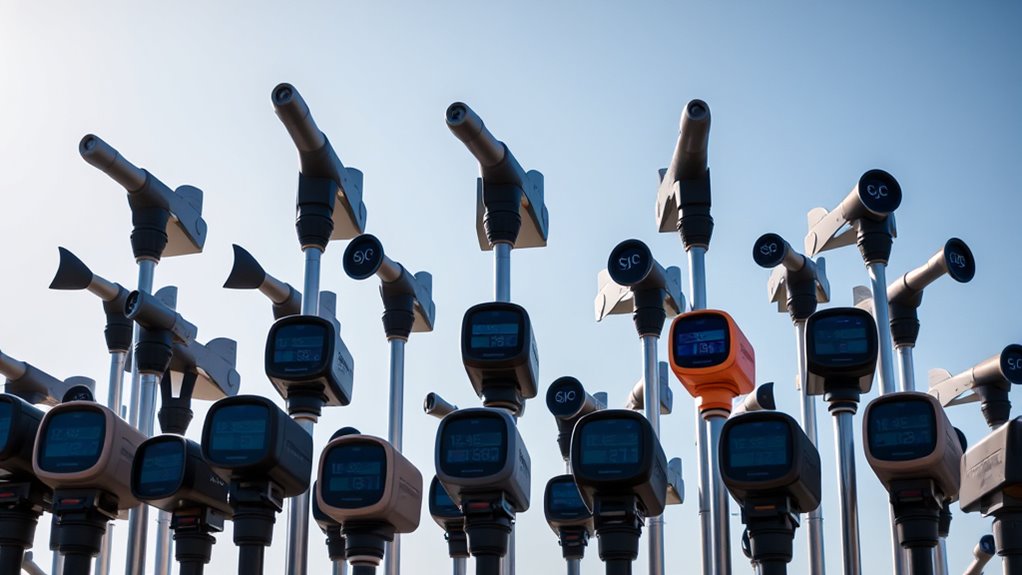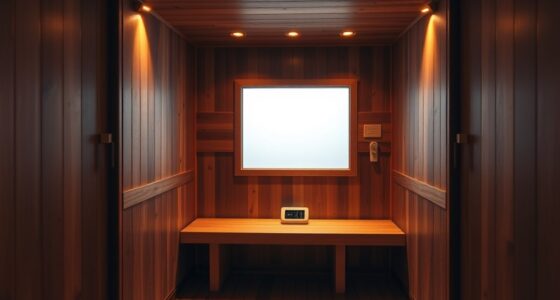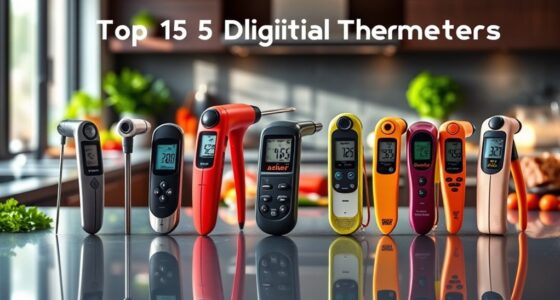I’ve put together a list of the 15 best anemometers of 2025 to help you find accurate measurements for all your needs. Whether you’re into outdoor activities or HVAC work, these devices are designed to offer precise readings of wind speed, temperature, and airflow. They come with user-friendly features for convenience and accuracy. If you’re interested in knowing which models made the cut and what to take into account when choosing one, keep going to find out more!
Key Takeaways
- Look for anemometers with measurement accuracy ranging from ±2% to ±5% to ensure reliable data for various applications.
- Select models that offer a wind speed range from 0.3 m/s to 67.1 mph for versatile performance in different environments.
- Consider user-friendly designs featuring ergonomic grips, intuitive buttons, and backlit displays for ease of use in low-light conditions.
- Opt for devices with real-time data logging capabilities, enhancing monitoring for timely adjustments in outdoor and industrial settings.
- Evaluate battery life, compatibility with rechargeable options, and features like automatic shut-off for longer usage and convenience.
BTMETER BT-100 Handheld Anemometer
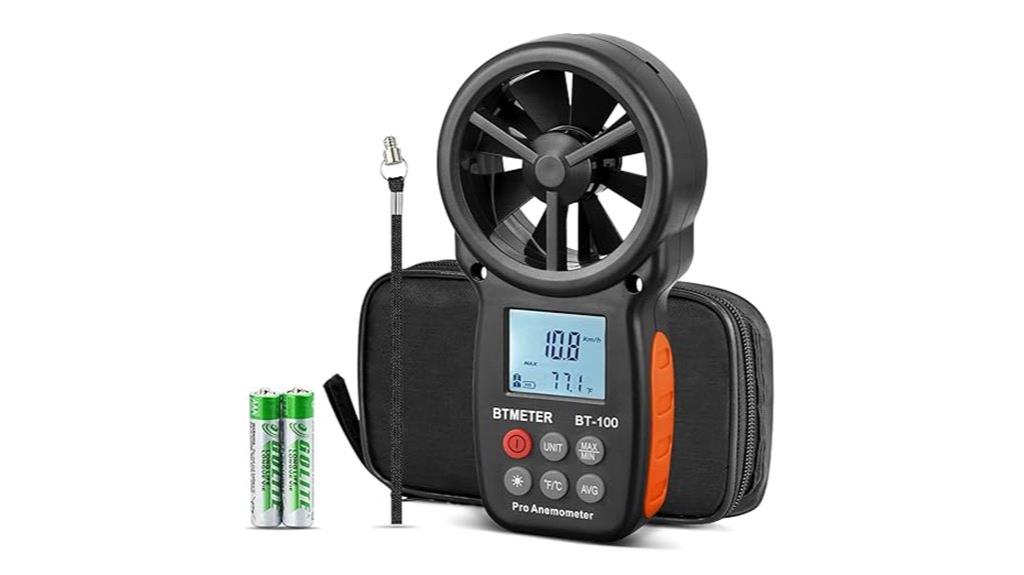
If you’re looking for a reliable anemometer that’s perfect for both professionals and outdoor enthusiasts, the BTMETER BT-100 Handheld Anemometer should be at the top of your list. This compact device measures wind speed, temperature, and wind chill accurately, with a speed range of 0.67 to 67.1 mph. I love its intuitive design and clear digital display, which makes navigation a breeze. The included protective case and tripod mounting option enhance its usability. Plus, it’s lightweight, making it easy to carry during outdoor activities. Overall, the BT-100 offers excellent value and performance for anyone needing precise wind measurements.
Best For: HVAC professionals and outdoor enthusiasts seeking a portable and accurate anemometer for wind measurements.
Pros:
- Compact and lightweight design for easy transport during outdoor activities.
- Intuitive interface with a clear digital display, making navigation simple.
- Includes protective case and tripod mounting option for enhanced usability.
Cons:
- Temperature readings may take time to stabilize in a new location.
- Lacks improved water resistance for outdoor use.
- Some users noted the device does not have an auto-off feature.
H12 Digital Anemometer Handheld Wind Speed Meter
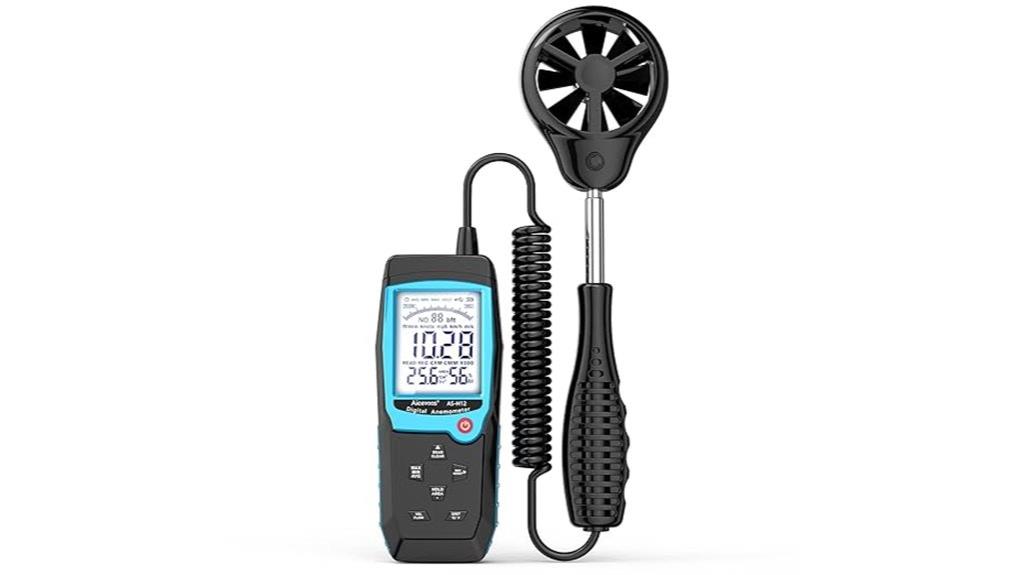
For anyone serious about outdoor activities like sailing, windsurfing, or even golf, the H12 Digital Anemometer Handheld Wind Speed Meter stands out as an essential tool. It measures wind speed, temperature, and humidity, displaying results in five different units. The extendable wind sensor makes it easy to access hard-to-reach spots. Plus, the backlit LCD screen guarantees you can read measurements even in bright sunlight. While it uses three AAA batteries and features an automatic shut-off, some users have noted minor issues with the manual. Overall, it’s a reliable choice for accurate measurements on the go.
Best For: The H12 Digital Anemometer is best for outdoor enthusiasts engaged in activities like sailing, windsurfing, and golfing who need reliable wind measurements.
Pros:
- Measures wind speed, temperature, and humidity in five different units for versatility.
- Extendable wind sensor allows for easy access to hard-to-reach areas.
- Big backlit LCD screen ensures visibility in bright sunlight.
Cons:
- Some users report minor issues with the manual, requiring experimentation to understand features.
- Initial debris on the impeller may affect readings until cleaned.
- The extendable feature may be inconvenient for users who prefer simpler, non-extending models.
Anemometer Handheld Digital Wind Speed Meter
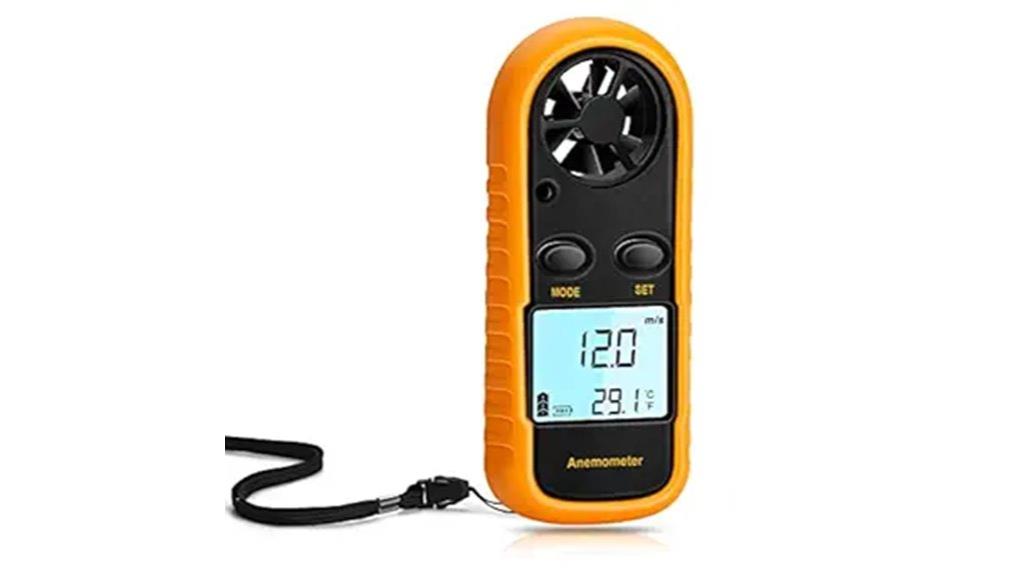
The Anemometer Handheld Digital Wind Speed Meter stands out as an excellent choice for outdoor enthusiasts and professionals alike, thanks to its ability to measure wind speed in five different units. Its compact design makes it easy to carry in my pocket, and the included lanyard adds convenience. I appreciate the LCD backlight for nighttime use and the straightforward operation; there’s no need for complicated steps. While some users noted sensitivity issues at lower speeds, I found it effective for various applications, from kite flying to HVAC testing. Just remember to manage battery life for peak performance.
Best For: Outdoor enthusiasts and professionals looking for a portable and versatile wind speed measurement tool.
Pros:
- Lightweight and compact design allows for easy portability.
- Measures wind speed in five different units, catering to various user needs.
- User-friendly operation with a backlit LCD for nighttime visibility.
Cons:
- Some users report low sensitivity issues at lower wind speeds.
- Battery drain can occur even when the device is turned off.
- Durability concerns have been noted, with mixed reviews on the product’s sturdiness.
HoldPeak 866B Digital Anemometer for Measuring Wind Speed and Temperature
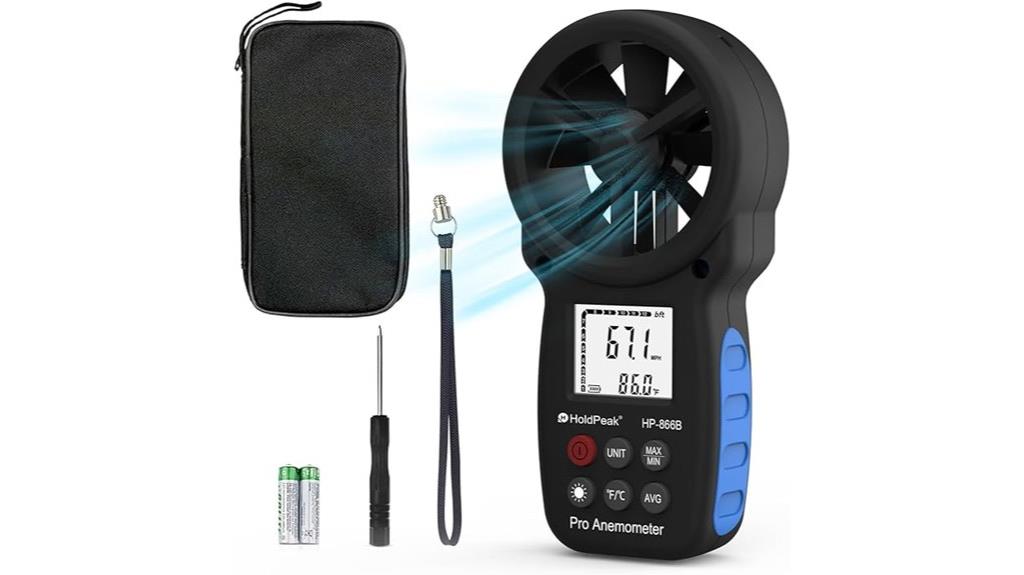
Measuring wind speed and temperature has never been easier with the HoldPeak 866B Digital Anemometer, making it an ideal tool for outdoor enthusiasts and professionals alike. This lightweight device boasts a measurement range of 0.67 to 67.1 mph with an accuracy of +/- 2%. I love the backlight feature and multiple unit options, which make it user-friendly in various conditions. Plus, the included waterproof pouch keeps it safe outdoors. While I’ve noticed some minor issues with MPH readings, overall, it’s a reliable choice for activities like golfing, surfing, or HVAC applications. You’ll appreciate its accuracy and functionality!
Best For: Outdoor enthusiasts and professionals who need a reliable tool for measuring wind speed and temperature.
Pros:
- Lightweight and portable design with a convenient hand strap and waterproof carrying pouch.
- Multiple measurement units and backlight feature enhance usability in different conditions.
- Accurate readings with Max/Min/Average wind speed functions, ideal for various outdoor activities.
Cons:
- Some users report inaccuracies in MPH readings.
- Battery cover can be difficult to remove, requiring a screwdriver for access.
- Minor issues reported regarding overall user experience with the device.
BTMETER BT-100 Handheld Anemometer for Air Flow Velocity Testing
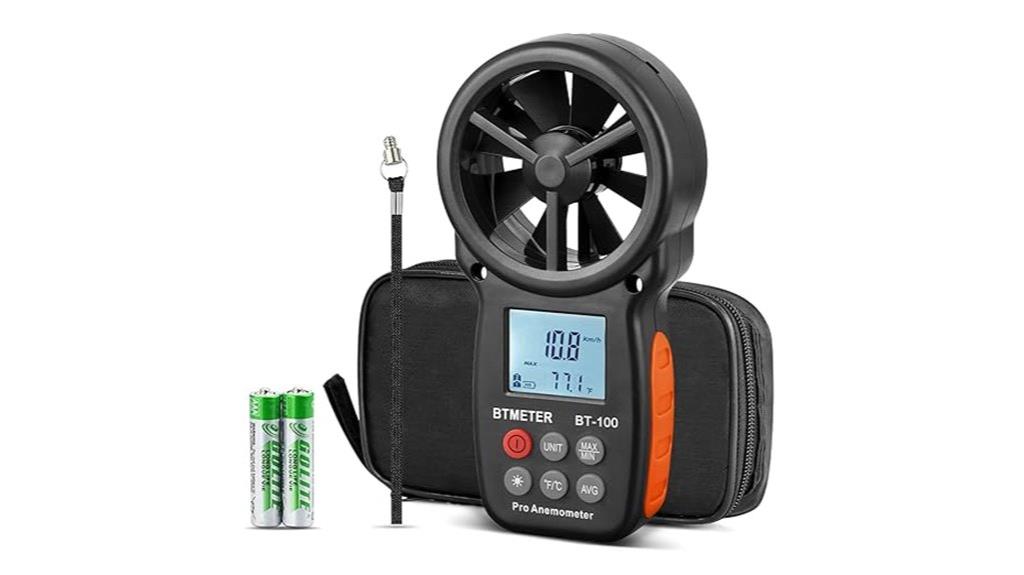
If you’re looking for a reliable tool to assess wind speed and air temperature, the BTMETER BT-100 Handheld Anemometer is an excellent choice for HVAC professionals and outdoor enthusiasts alike. This compact device measures air speed in five units and offers wind temperature readings from -10 to 60℃. I appreciate the clear digital display and the intuitive button layout, making it easy to navigate through modes. With a wind speed range of up to 67.1 mph, it delivers accurate readings. Plus, the protective case and wrist strap enhance portability, making it a must-have for anyone needing precise airflow measurements.
Best For: HVAC professionals and outdoor enthusiasts who need a reliable tool for measuring wind speed and air temperature.
Pros:
- Compact and lightweight design for easy portability during outdoor activities.
- Clear digital display with backlight for visibility in various lighting conditions.
- Intuitive button layout allows for easy navigation between measurement modes.
Cons:
- Temperature readings may take time to stabilize in new locations.
- Some users reported that the device does not auto-off, which could lead to battery drain.
- Suggestions for improvement include enhancing water resistance and simplifying battery installation.
Testo 405i Handheld Anemometer for Air Velocity and Temperature
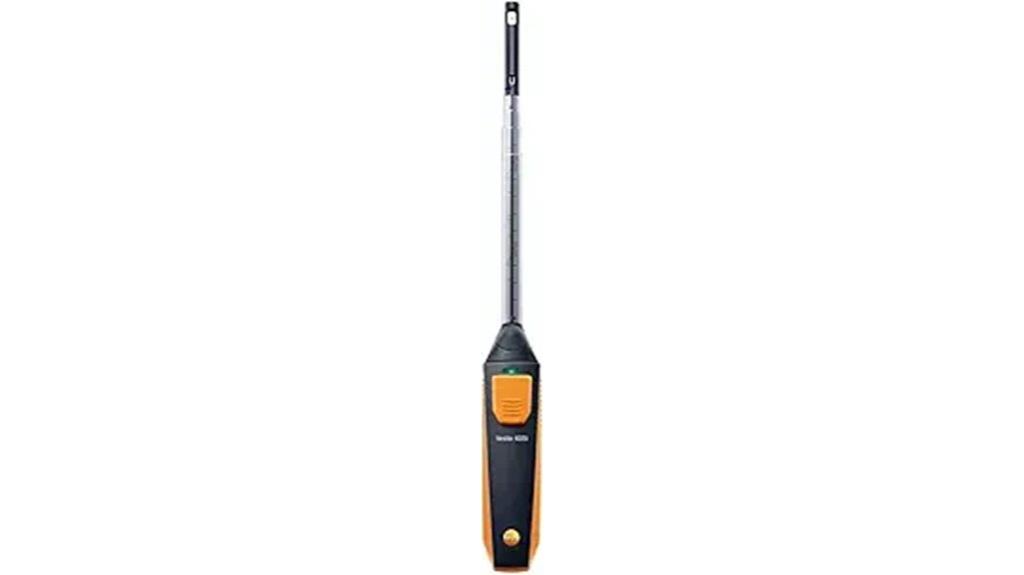
For HVAC professionals and enthusiasts looking for a reliable tool to measure air velocity and temperature, the Testo 405i Handheld Anemometer stands out with its Bluetooth capability and smart app integration. This compact device measures air velocity up to 5906 fpm and temperatures ranging from -4°F to 140°F, ensuring accurate readings every time. The rugged design and telescopic shaft make it easy to access hard-to-reach areas. I love how the Smart Probe app simplifies data collection, allowing me to generate reports effortlessly. With a 4.5-star rating, it’s no wonder this anemometer is a favorite among users.
Best For: HVAC professionals and enthusiasts seeking a portable and accurate tool for measuring air velocity and temperature.
Pros:
- Compact and lightweight design makes it easy to carry and use in various locations.
- Bluetooth connectivity and Smart Probe app facilitate remote measurements and data management.
- Rugged housing ensures durability and protection against impacts for long-lasting use.
Cons:
- Slower temperature response times may affect immediate readings in certain situations.
- Dependent on Bluetooth connectivity which may not be preferred by all users.
- Limited temperature range might not meet the needs of some specialized applications.
Anemometer Handheld Wind Speed Meter (AP-007)
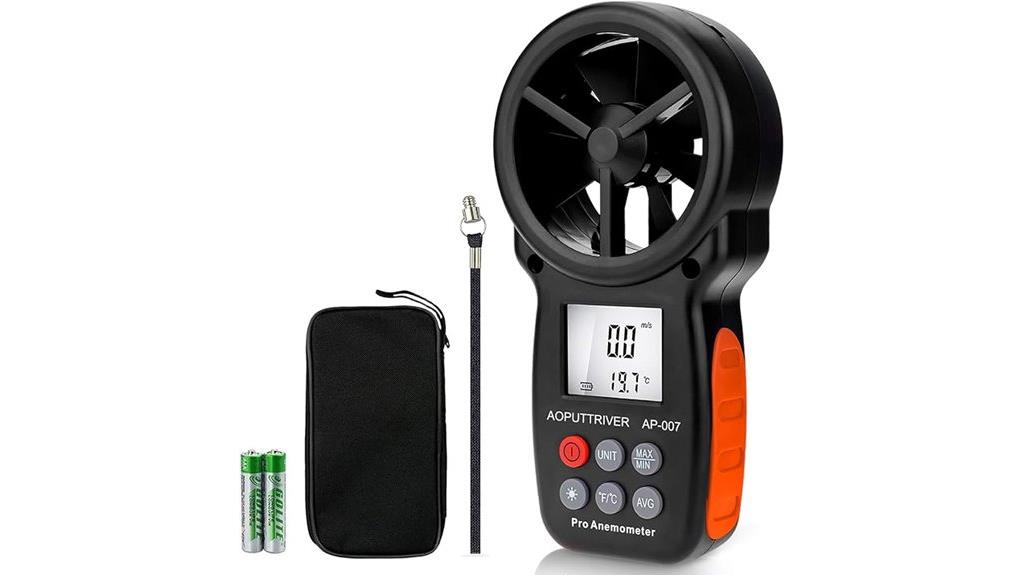
With its impressive range of wind speed measurement from 0.3 to 30 m/s, the Anemometer Handheld Wind Speed Meter (AP-007) is a top choice for outdoor enthusiasts and professionals alike. I love its compact design and the included tripod, which makes hands-free operation a breeze. It also measures temperature and airflow, making it versatile for activities like HVAC work and surfing. The backlight feature is handy for low-light conditions, and the wind chill function enhances accuracy. While some users note concerns about accuracy in high winds, it still boasts a solid 4.2-star rating from over 1,200 reviews.
Best For: Outdoor enthusiasts and professionals looking for a reliable and portable wind speed measurement tool.
Pros:
- Compact design for easy portability.
- Includes a handy backlight for use in low-light conditions.
- The tripod allows for hands-free operation during various activities.
Cons:
- Some users report concerns about accuracy in high wind conditions.
- Suggestions for additional accessories to enhance functionality.
- Limited temperature measurement range may not suit all applications.
Digital Wind Speed Meter Anemometer for Measuring Air Flow Velocity
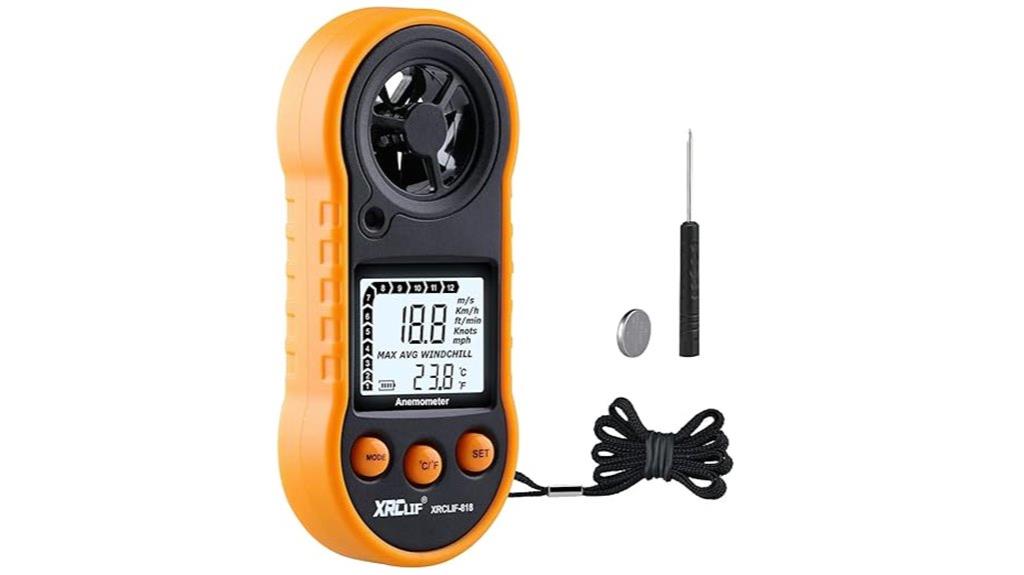
The Digital Wind Speed Meter Anemometer stands out as the best choice for outdoor enthusiasts and professionals alike, thanks to its ability to measure wind speeds up to 30 m/s and display real-time readings on an easy-to-read LCD screen. Its compact design fits perfectly in my pocket, making it convenient for any adventure. I love being able to switch between Celsius and Fahrenheit with just a button press. Plus, the backlight is handy for low-light conditions, though I wish it lasted longer. Overall, this anemometer’s accuracy and versatility make it a must-have for measuring airflow in various applications.
Best For: The Digital Wind Speed Meter Anemometer is best for outdoor enthusiasts and professionals who need accurate wind speed measurements for various applications.
Pros:
- Compact and lightweight design, easily portable for outdoor activities.
- User-friendly with quick unit switching between Celsius and Fahrenheit.
- Real-time readings displayed on an easy-to-read LCD screen, with wind chill indication.
Cons:
- Requires wind speeds of at least 2.5 mph to register measurements.
- Backlight duration of 12 seconds may be insufficient for some users.
- Battery installation can be challenging for a few users.
TS-301 Digital Anemometer, Wind Speed Meter
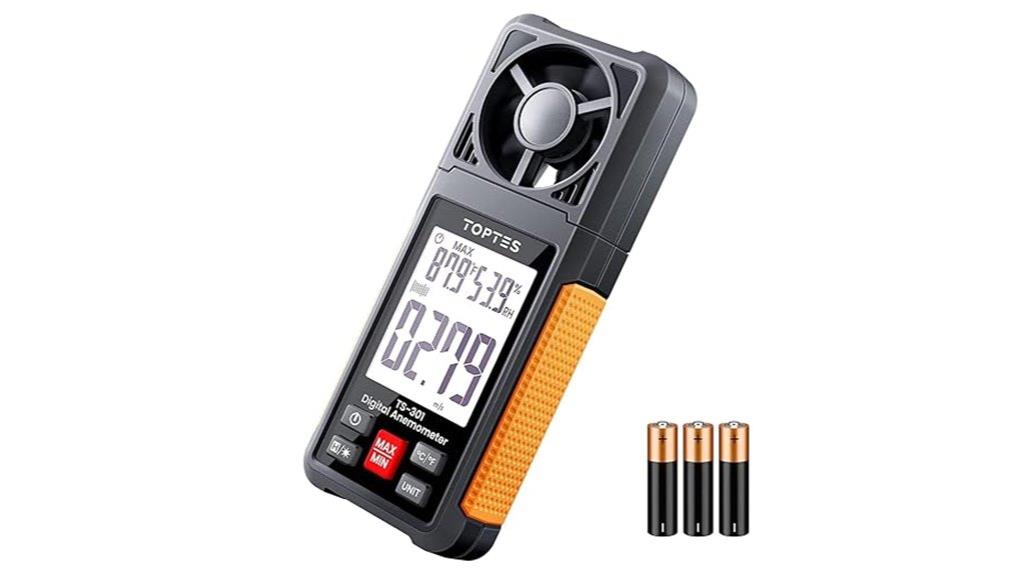
Ideal for outdoor enthusiasts, the TS-301 Digital Anemometer stands out with its large 2.26-inch backlit LCD screen that makes reading wind speeds effortless, even in bright sunlight. I love how lightweight and compact it is, fitting easily in my pocket during hikes or bike rides. It measures wind velocity in six different units, plus it tracks temperature and humidity, which is perfect for my sailing and drone flying adventures. While some users faced accuracy issues in high winds, I’ve found it reliable for most conditions. With a price under $20, it’s an excellent tool for anyone interested in wind measurement.
Best For: Outdoor enthusiasts, including sailors, drone flyers, and hikers, looking for a reliable and portable wind speed measurement tool.
Pros:
- Large, easy-to-read 2.26-inch backlit LCD screen for visibility in various lighting conditions.
- Lightweight and compact design allows for easy portability during outdoor activities.
- Measures wind speed in six different units and includes temperature and humidity sensors.
Cons:
- Some users have reported accuracy issues in high wind conditions.
- Lacks a tripod socket for continuous monitoring during extended use.
- Users may require time to familiarize themselves with all the functions and settings.
Digital Anemometer Handheld Wind Speed Meter
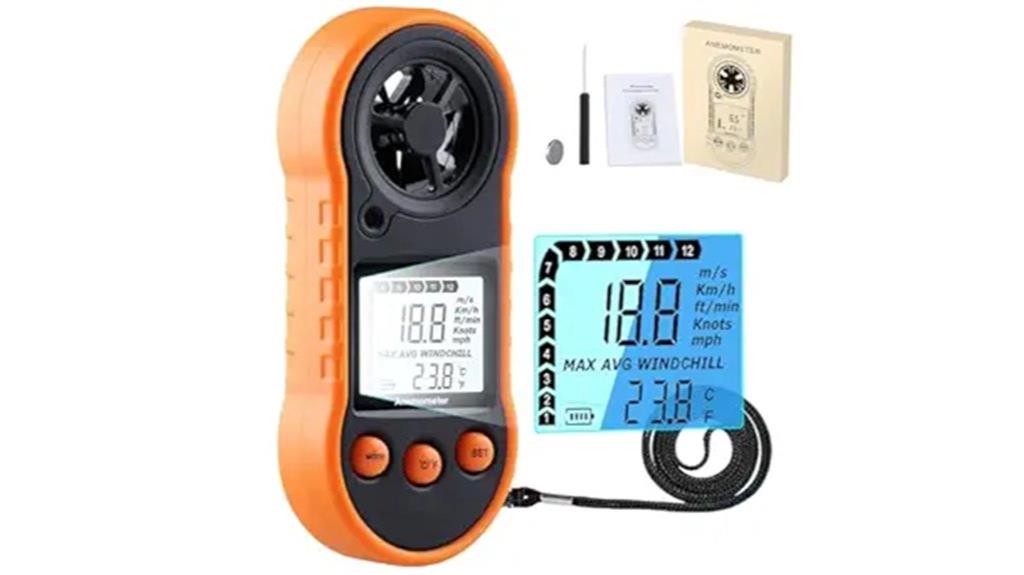
For anyone involved in outdoor activities or HVAC applications, the Digital Anemometer Handheld Wind Speed Meter stands out as a top choice in 2025. It measures wind speed in five different units and includes a temperature gauge, making it incredibly versatile. I love its compact design, weighing just 2.5 oz, which fits perfectly in my pocket. The backlight feature is a game-changer for low-light conditions. While the battery situation could be better, the accuracy and functionality make it worth it. Overall, I find it a reliable tool for monitoring wind speeds and temperatures, despite a few minor design flaws.
Best For: Outdoor enthusiasts, HVAC professionals, and anyone needing accurate wind speed and temperature measurements.
Pros:
- Compact and lightweight design for easy portability.
- Versatile measurement options with five wind speed units and temperature gauge.
- Backlight feature allows for use in low-light conditions.
Cons:
- Uses CR2032 watch batteries, which are less common than AAA batteries.
- Lack of an off button may lead to quicker battery drain.
- Build quality perceived as low due to plastic construction.
BTMETER Handheld Wind Speed Meter (BT-816B)
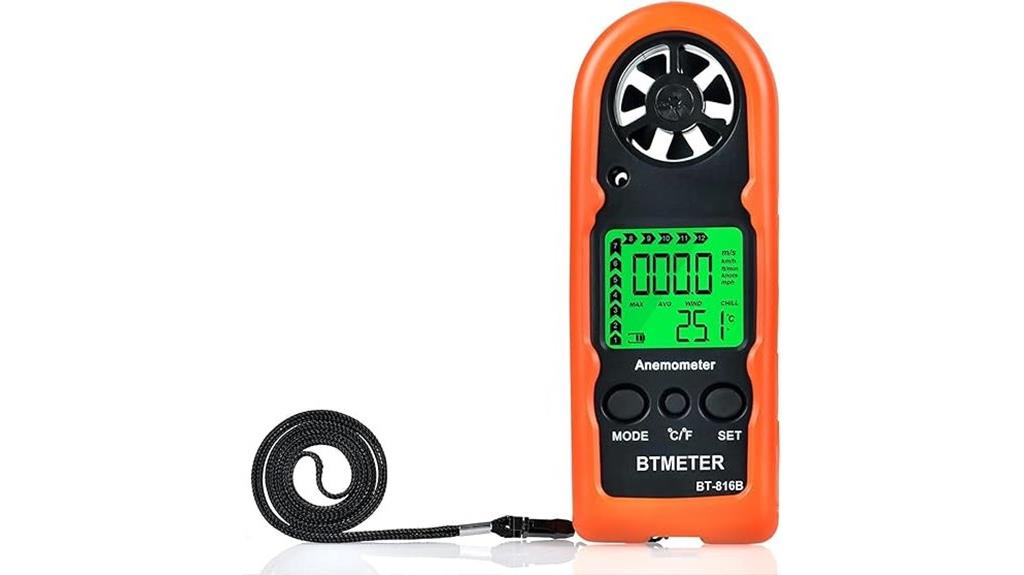
If you’re looking for a reliable and affordable wind speed meter, the BTMETER Handheld Wind Speed Meter (BT-816B) stands out with its impressive measurement range of 0.3 to 30 m/s. Weighing just 53g, its compact design makes it perfect for outdoor adventures like sailing or mountain climbing. I appreciate its multi-mode operation; the ability to switch units and view max, average, or current speeds is incredibly useful. Although some users mention accuracy issues at higher wind speeds, I find it delivers consistent readings for most activities. Plus, the 365-day warranty adds peace of mind for any potential concerns.
Best For: Outdoor enthusiasts and casual users seeking a cost-effective and portable wind speed meter for activities like sailing, mountain climbing, and HVAC testing.
Pros:
- Compact and lightweight design makes it easy to carry on outdoor adventures.
- Multi-mode operation allows for versatile use, including unit selection and wind chill measurement.
- Generally consistent readings and good value for non-professional applications.
Cons:
- Some users report accuracy issues at higher wind speeds (12 to 25 mph).
- Limited performance under certain conditions may affect reliability for specific needs.
- Mixed reviews indicate that while many find it effective, others have expressed dissatisfaction.
Pro HVAC Anemometer Handheld CFM Meter (Model AP-856A)

The Pro HVAC Anemometer Handheld CFM Meter (Model AP-856A) stands out with its impressive wind speed range of 0.001-100 mph, making it an essential tool for HVAC professionals who need precise measurements in various environments. I love how it measures not just wind speed but also air velocity and temperature, enhancing its versatility. The large backlit display is easy to read, and the USB data transmission feature allows for seamless analysis on my PC. With a solid customer rating of 4.4 stars, it’s clear that many appreciate its sensitivity and ease of use, making it a top choice for air flow measurement.
Best For: HVAC professionals and technicians seeking accurate measurements of wind speed, air velocity, and temperature in various environments.
Pros:
- Large backlit display for easy readability in different lighting conditions.
- USB data transmission feature facilitates convenient data analysis on a PC.
- Versatile functionality, measuring wind speed, air velocity, and temperature all in one device.
Cons:
- Some users report issues with the quality of the manual provided.
- Critiques regarding software compatibility may hinder data analysis for certain users.
- The automatic power-off feature after 5 minutes of inactivity may be inconvenient for some users.
Eisco Small Anemometer for Measuring Wind Speed
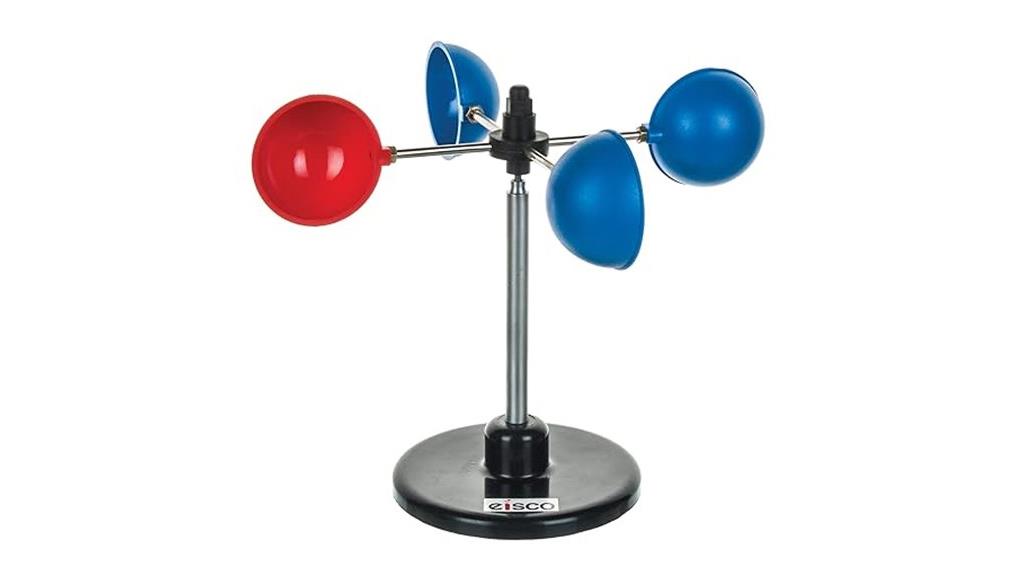
Eisco’s Small Anemometer stands out as an excellent choice for students and amateur meteorologists enthusiastic to measure wind speed effectively. Its compact design, measuring 7 inches tall and 8.5 inches in diameter, makes it easy to transport for classroom experiments or field studies. The rotating wind cups provide smooth measurements, although you’ll need to manually count rotations for accurate results, especially in high winds. Made from corrosion-resistant materials, it’s durable for outdoor use. However, I’ve noticed some concerns about the cups’ retention on the stem, which could affect performance in windy conditions. Overall, it’s a solid educational tool.
Best For: Eisco’s Small Anemometer is best for students and amateur meteorologists looking to accurately measure wind speed in educational settings or outdoor experiments.
Pros:
- Durable construction from corrosion-resistant materials, making it suitable for various weather conditions.
- Compact and portable design, ideal for classroom use and field studies.
- Provides smooth rotation of wind cups, enhancing measurement accuracy.
Cons:
- Requires manual counting of rotations for wind speed calculation, which can be challenging in high winds.
- Some concerns about the retention of rotating cups on the stem, potentially affecting performance in windy conditions.
- May not be suitable for serious meteorological use, as it seems more geared towards recreational purposes.
Extech 45118 Mini Waterproof Thermo Anemometer
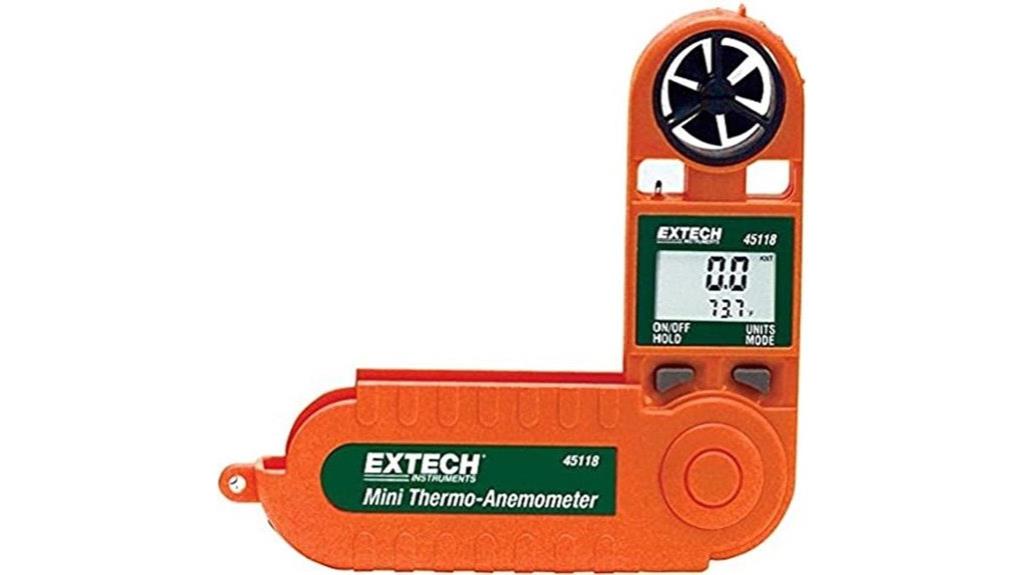
For anyone seeking a reliable and compact solution for measuring airspeed, the Extech 45118 Mini Waterproof Thermo Anemometer stands out as an excellent choice. Weighing just 0.1 kilograms and measuring only 5.3 x 2.8 x 0.8 inches, it’s perfect for on-the-go use. With an accuracy of +/-0.5%, it delivers precise wind readings, making it great for balancing A/C ducts. I appreciate the bright backlit display, though some users report concerns about its water resistance. Overall, its ease of use and functionality make it a top contender in the anemometer market. Plus, it comes with a one-year warranty for peace of mind.
Best For: Individuals or professionals looking for a portable and accurate tool to measure airspeed and CFM, particularly for HVAC applications.
Pros:
- Easy to use with a straightforward setup for airspeed measurement.
- High accuracy of +/-0.5% ensures reliable wind readings.
- Compact and lightweight design makes it convenient for on-the-go use.
Cons:
- Reports of potential limitations in water resistance, with moisture entering the unit after brief exposure.
- Some users have experienced issues with the anemometer’s blades.
- Configuration complexity may pose challenges for first-time users.
Pro HVAC Anemometer Handheld CFM Meter (AP-856A)
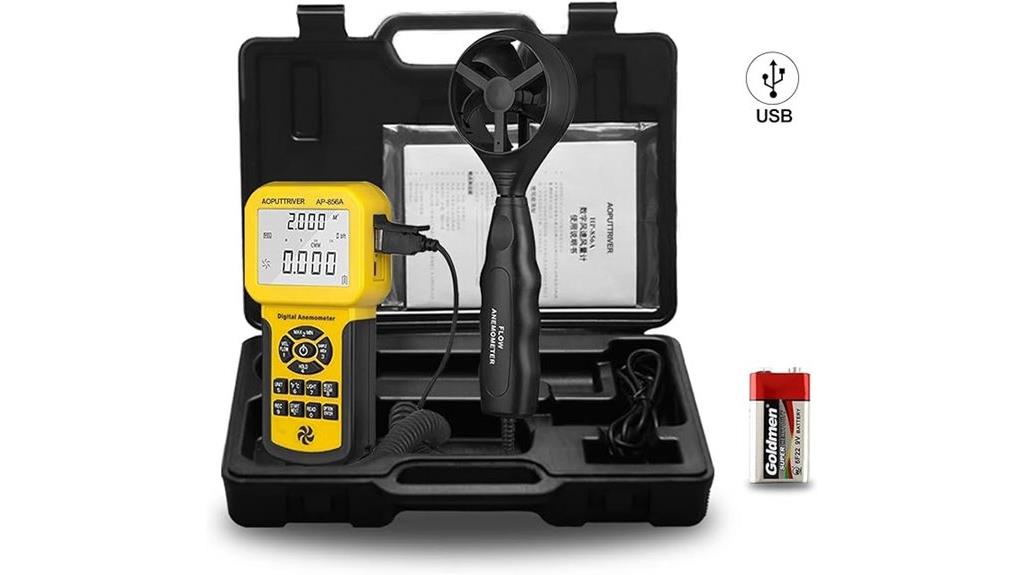
If you’re looking for a reliable tool to measure air flow in HVAC systems, the Pro HVAC Anemometer Handheld CFM Meter (AP-856A) stands out with its impressive wind speed range of 0.001-100 mph and an accuracy of +/- 3%. It measures wind speed, air velocity, and temperature, making it versatile for various applications. The large backlit display is easy to read, and the data hold function is handy. Plus, you can customize air flow calculations by inputting duct area. With a solid customer rating of 4.4 stars, it’s a great choice for balancing HVAC systems efficiently.
Best For: HVAC professionals and technicians looking for an accurate and versatile tool to measure air flow and balance systems.
Pros:
- Measures wind speed, air velocity, and temperature with high accuracy.
- Large backlit display and data hold function enhance usability in various lighting conditions.
- Customizable air flow calculations by inputting duct area for precise results.
Cons:
- Some users report issues with manual quality and clarity.
- Software compatibility may be limited for certain PC systems.
- Battery life may be shorter with frequent data transmission usage.
Factors to Consider When Choosing Anemometers

When choosing an anemometer, I think it’s crucial to evaluate a few key factors. Measurement accuracy, user-friendly design, and portability can really impact your experience and results. Plus, you’ll want to reflect on battery life and how versatile the device is for different applications.
Measurement Accuracy and Range
Choosing the right anemometer hinges on understanding measurement accuracy and range, both of which are essential for reliable wind data. I’ve found that measurement accuracy typically ranges from ±2% to ±5%, which can greatly affect your wind speed and temperature readings. Depending on the model, you can measure wind speeds from as low as 0.3 m/s up to 67.1 mph, suitable for everything from light breezes to strong gusts. Additionally, temperature ranges usually span from -10°C to 60°C (14°F to 140°F), making them versatile across various climates. If you need detailed airflow data, look for models with a resolution of 0.1 m/s, and features like maximum, minimum, and average speed recording can enhance your analysis of wind conditions over time.
User-Friendly Design Features
After understanding measurement accuracy and range, it’s time to evaluate how user-friendly an anemometer is. I always look for an intuitive button layout that makes it easy to switch between modes like max/min and average speed. A clear digital display with backlighting is essential, especially when I’m outdoors in varying light conditions. Ergonomic grips or hand straps are a must for comfort and to prevent drops. I also appreciate an automatic power-off feature; it helps save battery life, which is convenient if I forget to turn it off. These design elements enhance usability, making my experience more efficient whether I’m using the device for sports or professional assessments.
Portability and Weight Considerations
Portability matters greatly to me when selecting an anemometer, especially for outdoor adventures. I look for lightweight designs that typically weigh between 4 to 7 ounces, making it easy to slip one into my pocket or backpack. Compact models, around 3 to 6 inches in size, fit perfectly without taking up much space. I appreciate that many come with protective cases or straps, ensuring my device stays secure while I’m on the move. The ease of battery replacement, often using standard AAA or CR2032 batteries, is a plus since I don’t need any special tools. Some even feature a tripod mount, allowing for hands-free operation, which is great when I need to measure wind speed over extended periods.
Battery Life and Power
When I evaluate anemometers, battery life and power efficiency are essential factors that can make or break my outdoor experience. Many models operate on standard batteries like AAA or CR2032, but some include batteries while others don’t, impacting convenience. I’ve noticed battery life varies widely; some anemometers have an automatic shut-off feature that conserves power after inactivity, which I find useful. I also prefer devices compatible with rechargeable batteries to save on long-term costs. Low battery indicators on displays help me monitor power levels, preventing unexpected shutdowns during critical measurements. Finally, easy-access battery compartments without requiring tools for replacement streamline my use, making my outdoor adventures more enjoyable and efficient.
Application Versatility and Use Cases
While I explore different anemometers, I always consider their application versatility and use cases, as these factors can greatly influence my decision. Anemometers that measure wind speed, temperature, humidity, and airflow are invaluable for outdoor activities, HVAC systems, and industrial applications. I appreciate models with extendable sensors, which make it easier to access challenging locations, especially for confined space measurements. Handheld options that offer multiple unit measurements cater to various user preferences across regions. Additionally, real-time data logging features enable effective monitoring for air quality assessments and HVAC diagnostics. Usability enhancements like backlit displays and battery indicators are essential for low-light conditions and extended use, ensuring that I can rely on my anemometer no matter the situation.
Frequently Asked Questions
What Is the Typical Lifespan of an Anemometer?
The typical lifespan of an anemometer really depends on its type and usage. From my experience, most well-maintained anemometers last anywhere from 5 to 15 years. If you’re using it in harsh conditions, like extreme weather, it might wear out sooner. I always recommend checking for signs of wear and tear regularly, so you can replace it before it affects your measurements. Keeping it clean and calibrated can also extend its life considerably!
How Do I Calibrate My Anemometer?
I know calibrating an anemometer might seem intimidating, but it’s actually pretty straightforward. First, I make sure it’s clean and free from obstructions. Then, I compare its readings with a reliable reference, like a handheld anemometer. If there’s a discrepancy, I adjust the calibration settings according to the manufacturer’s instructions. Regular calibration keeps my measurements accurate, which is essential for any project I’m working on. Don’t worry; it gets easier with practice!
Can Anemometers Measure Humidity?
I’ve often wondered if anemometers can measure humidity, and the short answer is, they generally can’t. Anemometers primarily measure wind speed and direction. However, some advanced weather stations combine anemometers with hygrometers to provide both wind and humidity readings. If you need humidity data, I’d recommend looking for a multi-function weather station instead. That way, you’ll get accurate readings for both wind and humidity in one handy device!
What Is the Difference Between Handheld and Stationary Anemometers?
When I think of handheld and stationary anemometers, I picture a surfer and a lighthouse. The handheld ones are like surfers, catching the wind wherever they go, perfect for quick measurements on the beach. In contrast, stationary anemometers are like lighthouses, steadfastly observing wind patterns over time. Handheld models offer portability and instant readings, while stationary ones provide consistent, long-term data, making both essential for understanding the winds we navigate.
Are There Any Maintenance Tips for Anemometers?
Absolutely, maintaining your anemometer is essential for accurate readings. I always check the calibration regularly and clean the sensor using a soft cloth to prevent dust buildup. It’s important to store it properly, away from extreme temperatures or moisture. I also recommend inspecting the device for any signs of wear and tear, especially after heavy use. Following these tips keeps my anemometer in top shape, ensuring reliable performance every time I use it.
Conclusion
In wrapping up, choosing the right anemometer can truly enhance your projects, whether you’re a hobbyist or a professional. For instance, I remember a friend who used the Extech 45118 on a sailing trip. It helped him gauge wind speeds accurately, optimizing their sail adjustments and ultimately resulting in a thrilling, faster ride. So, explore the options we’ve discussed, and find the perfect match for your wind measurement needs—you won’t regret it!
